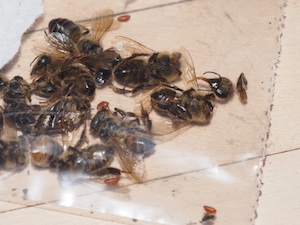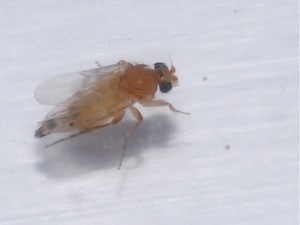Parasitized honey bees found in Vermont
Citizen science project, ZombeeWatch.org, reports "zombees" in New England
Parasitized honey bees, or "zombees," have now been spotted for the first time in New England, according to researchers at San Francisco State University. The University’s web-based project, ZomBee Watch, reported the find today on its web site (http://www.zombeewatch.org).
SF State Professor of Biology John Hafernik and colleagues first identified parasitized honey bees in 2011. After being infected with a fly parasite, the bees abandon their hives to congregate at night near lights, dying after a bout of disoriented, "zombie-like" behavior. Hafernik and other researchers are tracking the phenomenon with the help of more than 1,500 citizen scientists who report possible parasitized bee sightings to ZomBee Watch.

Fly pupae emerge from the bodies of parasitized honey bees found in Vermont.
Until now, zombee sightings were limited to the U.S. West Coast and South Dakota. But this September, a Chittenden County, Vt. beekeeper discovered dead bees under his porch and landscaping lights.
The beekeeper, who requested to remain anonymous, submitted photos and the pupae of the parasitic phorid flies that burst out of the dead honey bees to the SF State project. Brian Brown, a phorid fly expert at the Natural History Museum of Los Angeles County, identified the pupae and adult flies as Apocephalis borealis, the parasite behind zombee infestations.
Brown has studied this group of flies and found that A. borealis naturally occurs throughout the continent. "It is the presence of parasitized 'zombie' honey bees that is the new East Coast discovery," he said.
The Vermont zombees add another piece to the puzzle that Hafernik and colleagues have been piecing together for several years. "We’ve always thought it was possible that we would see different things in different parts of the fly's range, maybe differences in their ability to parasitize their hosts," Hafernik explained. "This suggests that this phenomenon is more broadly occurring across the United States."
"This find is also a great example of the power of citizen science to make important contributions," he added.
The zombee research team continues to study how honey bees are parasitized by the phorid. Brown said parasitic wasps, which have been studied much more extensively than parasitic flies, may offer some clues. "There's probably more than just something mechanically chomping away in those bodies," he noted. "In the case of the wasps, there's an entire biochemical package that’s delivered that in some cases has very sophisticated effects on its host's behavior."

Apocephalis borealis, the parasite behind the zombee infestations, is now infecting honey bees in New England.
Beekeepers "who find their hives are infected should stay calm and use the best beekeeping practices to keep their hives as healthy as possible," Hafernik said. "It's most likely that healthy hives are best able to survive, whether it be phorid fly infections or varroa mites or any of the other pathogens they're experiencing, probably at the same time in many cases."
He stressed that it's still an open question as to how widespread the zombee phenomenon is, and he urged more individuals to join the zombee hunt. The team has prepared a series of videos to help new hunters get started.
"We have a window of opportunity for people to make observations, but that window is going to close very quickly as winter comes in, especially in the east," he said.
Hafernik and his colleagues launched the ZomBeeWatch.org website in 2012 to encourage citizen scientists to report cases of honey bees infected by the phorid fly parasite, which were first discovered on the SF State campus. Since then, more than 100,000 people have visited the ZomBee Watch site, and some 1,500 zombee hunters have registered to submit their data on possible honeybee infections. About a quarter of the participants are beekeepers, while the rest are interested citizens doing their part to help track this new threat to honey bees.
###
SF State is the only master's-level public university serving the counties of San Francisco, San Mateo and Marin. The University enrolls nearly 30,000 students each year and offers nationally acclaimed programs in a range of fields -- from creative writing, cinema and biology to history, broadcast and electronic communication arts, theatre arts and ethnic studies. The University’s more than 219,000 graduates have contributed to the economic, cultural and civic fabric of San Francisco and beyond.